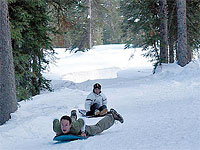
Helmets can significantly reduce the risk of a head injury from sledding (photo by Adam Baker)
Heavy winter storms have been blanketing mountains in the west this Christmas, leaving several feet of fresh snow. Unfortunately, fresh snow combined with steep mountain terrain has proven deadly for three people already, with two more still unaccounted for, as of Christmas night.
On Wednesday, two snowmobilers were killed in Logan, UT and on Thursday, a skier was killed at the Squaw Valley ski resort, near Lake Tahoe, CA. What is interesting about these tragedies is that all three men were experienced locals who were equipped with locater beacons. Familiarity can lead to apathy, though, as avalanche conditions were extremely high around the region and authorities had issued warnings telling people about the danger.
Most avalanches occur during, or just after, heavy snowstorms. Fresh snow does not bond well with the existing snow layer, and the added weight increases the chance that a slide may occur. It is always important to check the avalanche conditions before venturing into the winter backcountry. Reports on local conditions are available online via the Forest Service National Avalanche Center.
Even if your winter recreational plans don’t involve steep terrain and high-speed sports, helmets can still be an important and often overlooked piece of safety equipment that can protect your children from head injuries. According to the National Safety Council there are about 33,000 sledding injuries that require hospital emergency care, every year.
Most of us wouldn’t let our kids ride bikes without their helmets but, when it comes to sledding, we often overlook the fact that packed snow and ice can be just as hard as asphalt. In addition, sleds are not nearly as maneuverable as bicycles, making obstacles such as trees and other sledders much more dangerous. Sled runs often tend to be crowded, as many sledders vie for turns on the best run, making collisions much more likely.
You don’t have to be involved in extreme sports to sustain injuries in the winter, so do your family a favor and follow some basic safety precautions this year. Check the local snow conditions before venturing out and dust-off the bike helmets for a fun, and safe, day of sledding.
See also…

Pingback: » Using Your Noggin While Sledding